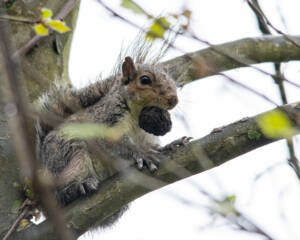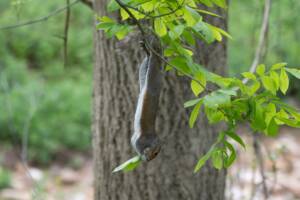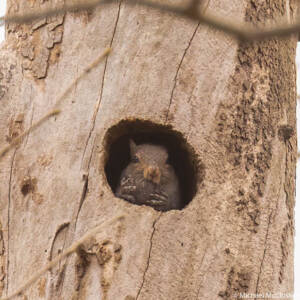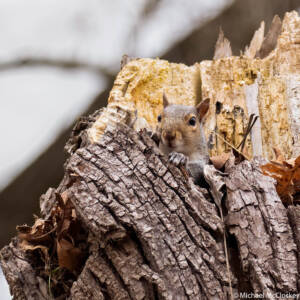Eastern Gray Squirrels
Story by John Canoles Photos by Ferd Brundick, Dave Bob Schmidt, Dave Hepner & Mike McCloskey (in order)
The eastern skies glows with an orange sherbet tint behind the naked treetops that line the ridges above Minebank Run. Another winter morning is just beginning, and a flying squirrel has just settled into a leafy nest, resting after a full night of activity. After successfully finding a bounty of nuts and seeds and evading the outstretched talons of a great horned owl, the flying squirrel survived another 24 hours in the wild.
 Restlessly, in a leafy nest in the same old silver maple at the edge of the forest, a gray squirrel stirs from its night of sleep to begin its day facing the challenges of survival. Yesterday’s snow has blown free from the tree limbs, but a coating remains on the ground below. The squirrel stretches in the first light of the morning and scampers effortlessly out the limb of the maple.
Restlessly, in a leafy nest in the same old silver maple at the edge of the forest, a gray squirrel stirs from its night of sleep to begin its day facing the challenges of survival. Yesterday’s snow has blown free from the tree limbs, but a coating remains on the ground below. The squirrel stretches in the first light of the morning and scampers effortlessly out the limb of the maple.
Though larger and more terrestrial than the flying squirrel, the gray squirrel is still quite acrobatic and moves through the canopy of the forest with ease. It runs out to the branch until its weight overwhelms the smaller branches at the edge of the canopy and leaps off to a sturdier perch on the adjacent tree. It covers ground quickly in the same manner, branch to branch, tree to tree, in search of today’s food source.
Though truly an omnivore, its primary source sources of food are vegan with seeds, nuts, berries and buds fulfilling most of its diet. When food is scarce or an undeniable opportunity presents itself, the gray squirrel will feed on insects, amphibians, bird eggs and even young birds. Gray squirrels are particularly adapted to winter survival, storing away seeds and nuts in caches that are used during the thin days of winter.
fulfilling most of its diet. When food is scarce or an undeniable opportunity presents itself, the gray squirrel will feed on insects, amphibians, bird eggs and even young birds. Gray squirrels are particularly adapted to winter survival, storing away seeds and nuts in caches that are used during the thin days of winter.
The squirrels and their favored food suppliers, the oaks, have evolved an “understanding” about which acorns to eat and which acorns to store. White oak acorns will rot quickly while red oak acorns contain more tannins that allow them to stay viable through the winter. The lack of tannins in the white oak acorns mean means they are better tasting and will be eaten first by the squirrels, while the red oak group acorns are stored for later feasting. Had the reverse been true, acorn storage would not be as effective a long-term food source because the cached acorns would have rotted overwinter.
Though well adapted to the hide and re-find strategy of caching acorns and other nuts, squirrels are not 100 percent efficient in their recovery efforts, so they do end up inadvertently planting many acorns and nuts that do germinate, helping to propagate new plants. Squirrels, however, are not the best forest planters because they generally do not bury the seeds too far from the parent tree. An acorn of hickory planted within the forest is less likely to develop than a seed planted at the edge of the forest or in a field. This service is best provided to the oaks by the blue jays whose scatter hoarding technique of acorn caching disperses the seeds as much as a mile from the parent tree.
 On this sunny winter day, the gray squirrel scrambles through the forest and out a hedgerow that follows along a field toward a nearby residence. The squirrels’ home range can cover as much as 5 acres but they rarely spend time in open fields or lawns. Daring dashes across open areas make them much more susceptible to predation than when they stick to the trees. Ignoring the walnuts that still litter the ground below, the squirrel heads quickly toward a feeder station where ample sunflower seeds are available for only the cost of some acrobatics to defeat the squirrel proof baffles and spring-loaded feeder ports. Though the squirrel has cached many acorns, nuts and other seeds, an available of supply of seeds will be used whenever weather permits. Stored seeds will be eaten when long trips to the feeders are discouraged by weather or predators.
On this sunny winter day, the gray squirrel scrambles through the forest and out a hedgerow that follows along a field toward a nearby residence. The squirrels’ home range can cover as much as 5 acres but they rarely spend time in open fields or lawns. Daring dashes across open areas make them much more susceptible to predation than when they stick to the trees. Ignoring the walnuts that still litter the ground below, the squirrel heads quickly toward a feeder station where ample sunflower seeds are available for only the cost of some acrobatics to defeat the squirrel proof baffles and spring-loaded feeder ports. Though the squirrel has cached many acorns, nuts and other seeds, an available of supply of seeds will be used whenever weather permits. Stored seeds will be eaten when long trips to the feeders are discouraged by weather or predators.
On this day a red-tailed hawk sits in a large poplar at the edge of the lawn, overlooking the feeders. Across the yard a Cooper’s hawk is also perched keenly watching the activity. The two hawks have the same purpose, though different quarry. The red tail is eyeing the squirrels, the Cooper’s hawk the various birds. A large Cooper’s hawk could capture a squirrel, but the battle would be challenging. The red-tailed hawk is large enough to capture the squirrel but will need a bit of luck to capture the agile prey. Ambush-style attacks are the best bet for each of these predators, slipping in unnoticed and grabbing unwary prey.
The feeder station is full of noise, chips and clucks from the many birds feeding there and scolding calls from the squirrels at the feeders and in the nearby trees. Apparently one or both of the predators has been spotted and all the birds are on high alert. The slightest muscle twitch from the predators will send the group dashing for safety. For now, the hawks sit and wait. They know that if they are patient, they will be forgotten.
Several squirrels gambol amongst themselves, jumping between feeders and chasing off birds that venture too close. The squirrels are tolerant of each other as long as food sources are stocked. Though squirrels do maintain a home range, they do not generally defend a territory, instead sharing the world with their neighbors. Good den trees, however, are a different story and females will defend nest sites from others was spring approaches.
venture too close. The squirrels are tolerant of each other as long as food sources are stocked. Though squirrels do maintain a home range, they do not generally defend a territory, instead sharing the world with their neighbors. Good den trees, however, are a different story and females will defend nest sites from others was spring approaches.
After a while the gray squirrel heads back along the hedgerow, this time stopping to gnaw on the tough coat of an old walnut. Like all rodents, its teeth never stop growing. Chewing the tough shell of the walnut helps to wear down its teeth and keeps them healthy. To the trees once again the squirrel is scampering along limbs and leaping between branches, ever wary for predators as it moves back toward its nest for a midday rest. Later it will reemerge for another feeding before turning the forest back over to the now resting fly squirrel, its nocturnal counterpart in the forest.

